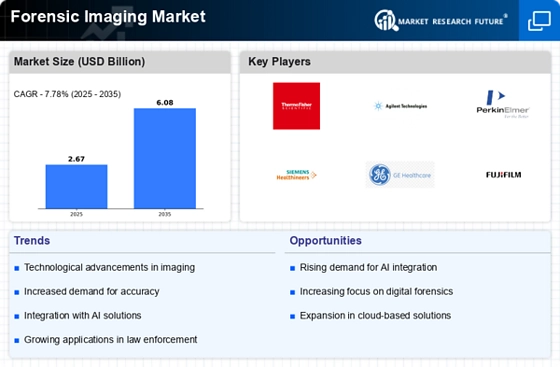Rising Crime Rates
The Forensic Imaging Market appears to be significantly influenced by the rising crime rates observed in various regions. As law enforcement agencies face increasing challenges in solving crimes, the demand for advanced forensic imaging technologies has surged. This trend is particularly evident in urban areas, where violent crimes and cybercrimes have escalated. According to recent statistics, the need for effective imaging solutions in criminal investigations has led to a projected growth rate of approximately 8% annually in the forensic imaging sector. This growth is likely to continue as authorities seek to enhance their investigative capabilities, thereby driving the market forward.
Growing Adoption in Legal Proceedings
The growing adoption of forensic imaging in legal proceedings is a notable driver for the Forensic Imaging Market. Legal professionals increasingly rely on high-quality imaging to present evidence in court, ensuring that visual data is both compelling and credible. This trend is particularly pronounced in civil litigation and criminal cases, where the clarity of evidence can significantly impact outcomes. As a result, the demand for advanced imaging technologies that can produce reliable and reproducible results is on the rise. Market analysts project that this trend will contribute to a steady growth rate of approximately 7% in the forensic imaging market, as legal entities seek to leverage technology for better case management.
Emerging Applications in Cybersecurity
Emerging applications of forensic imaging in cybersecurity are becoming increasingly relevant in the Forensic Imaging Market. As cyber threats evolve, the need for effective imaging solutions to investigate digital crimes is paramount. Forensic imaging plays a crucial role in capturing and analyzing digital evidence, which is essential for identifying perpetrators and preventing future attacks. The market for cybersecurity-related forensic imaging is anticipated to grow significantly, with estimates suggesting a growth rate of around 12% annually. This trend underscores the importance of adapting forensic imaging technologies to meet the challenges posed by the digital landscape, thereby expanding the market's reach and potential.
Integration of Artificial Intelligence
The integration of artificial intelligence (AI) into forensic imaging technologies is transforming the Forensic Imaging Market. AI algorithms are increasingly being utilized to analyze images and videos, improving the accuracy and speed of investigations. This technological advancement allows forensic experts to identify critical evidence more efficiently, which is essential in time-sensitive cases. The market for AI-driven forensic imaging solutions is expected to expand rapidly, with estimates suggesting a compound annual growth rate of around 10% over the next five years. This integration not only enhances the effectiveness of forensic investigations but also attracts investment in the sector, further propelling market growth.
Increased Investment in Forensic Technologies
Increased investment in forensic technologies is a critical driver for the Forensic Imaging Market. Governments and private organizations are recognizing the importance of modernizing forensic capabilities to enhance public safety and improve crime-solving rates. This investment is reflected in the procurement of state-of-the-art imaging equipment and software, which are essential for accurate evidence collection and analysis. Recent funding initiatives have allocated millions of dollars towards upgrading forensic labs and training personnel in advanced imaging techniques. As a result, the market is expected to experience a robust growth trajectory, with projections indicating a potential increase of 9% in market size over the next few years.


















Leave a Comment